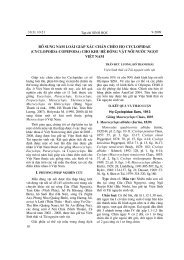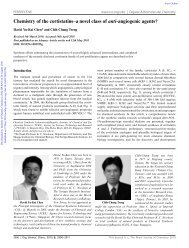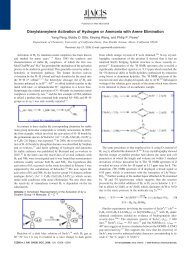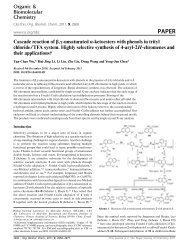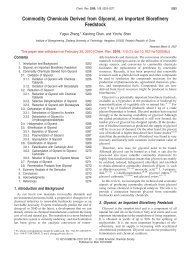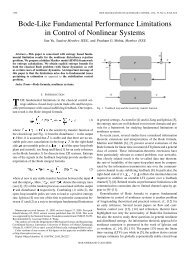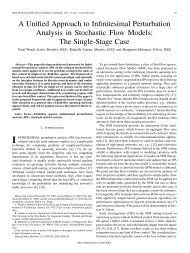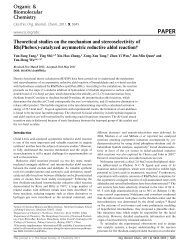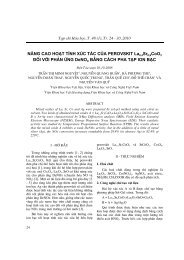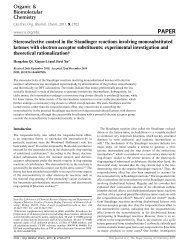PAPER Effect of surfactants on the chemiluminescence of acridinium ...
PAPER Effect of surfactants on the chemiluminescence of acridinium ...
PAPER Effect of surfactants on the chemiluminescence of acridinium ...
You also want an ePaper? Increase the reach of your titles
YUMPU automatically turns print PDFs into web optimized ePapers that Google loves.
Hinze et al. have reported that <strong>the</strong> fluorescence quantum yields,<br />
fluorescence lifetimes and fluorescence emissi<strong>on</strong> spectra <str<strong>on</strong>g>of</str<strong>on</strong>g> Nmethylacrid<strong>on</strong>e<br />
(NMA) in water, as well as in soluti<strong>on</strong>s <str<strong>on</strong>g>of</str<strong>on</strong>g> cati<strong>on</strong>ic,<br />
zwitteri<strong>on</strong>ic, ani<strong>on</strong>ic and n<strong>on</strong>-i<strong>on</strong>ic <str<strong>on</strong>g>surfactants</str<strong>on</strong>g> are very similar. 31a<br />
The fluorescence quantum yield <str<strong>on</strong>g>of</str<strong>on</strong>g> this acrid<strong>on</strong>e was close to unity<br />
in <strong>the</strong>se different media as well as in alcoholic solvents (methanol,<br />
ethanol and 2-propanol) but decreased in less polar solvents such<br />
as dimethyl sulfoxide and dimethyl formamide. For example, <strong>the</strong><br />
emissi<strong>on</strong> wavelength maximum, fluorescence quantum yield and<br />
fluorescence lifetime for NMA in water was observed to be 431 nm,<br />
1.00 and 15.8 ns, respectively. In a 5 mM soluti<strong>on</strong> <str<strong>on</strong>g>of</str<strong>on</strong>g> CTAC, <strong>the</strong><br />
emissi<strong>on</strong> wavelength maximum, fluorescence quantum yield and<br />
fluorescence lifetime were 427 nm, 0.97 and 15.2 ns, respectively. In<br />
a previous study, we had also observed that <strong>the</strong> <strong>chemiluminescence</strong><br />
emissi<strong>on</strong> wavelength maximum <str<strong>on</strong>g>of</str<strong>on</strong>g> an N-sulfopropyl <strong>acridinium</strong><br />
ester, which forms electr<strong>on</strong>ically excited N-sulfopropylacrid<strong>on</strong>e,<br />
in <strong>the</strong> presence <str<strong>on</strong>g>of</str<strong>on</strong>g> CTAC is 426 nm. 2<br />
Siegmund et al. studied singlet–triplet dynamics <str<strong>on</strong>g>of</str<strong>on</strong>g> NMA in<br />
a wide range <str<strong>on</strong>g>of</str<strong>on</strong>g> solvents 31b and also observed lower fluorescence<br />
quantum yields in n<strong>on</strong>-polar solvents for NMA as well as for<br />
acrid<strong>on</strong>e and N-phenylacrid<strong>on</strong>e. 31b,c In halogenated solvents where<br />
<strong>the</strong> fluorescence quantum yield <str<strong>on</strong>g>of</str<strong>on</strong>g> NMA was significantly lower,<br />
kinetics <str<strong>on</strong>g>of</str<strong>on</strong>g> intersystem crossing were 5–10 fold higher. 31b Arelated<br />
study by Mory et al. <strong>on</strong> a series <str<strong>on</strong>g>of</str<strong>on</strong>g> acrid<strong>on</strong>es with different N-alkyl<br />
groups showed that <strong>the</strong> first singlet excited state is populated in<br />
polar solvents and <strong>the</strong> first triplet state is populated in n<strong>on</strong>-polar<br />
solvents. 31d<br />
The fact that <strong>the</strong> fluorescence quantum yield <str<strong>on</strong>g>of</str<strong>on</strong>g> NMA is<br />
<strong>the</strong> same in water and surfactant soluti<strong>on</strong>s 31a al<strong>on</strong>g with data<br />
published by Siegmund et al. 31b <strong>on</strong> singlet–triplet dynamics <str<strong>on</strong>g>of</str<strong>on</strong>g><br />
acrid<strong>on</strong>es suggests that in <strong>the</strong> chemiluminescent reacti<strong>on</strong> <str<strong>on</strong>g>of</str<strong>on</strong>g><br />
<strong>acridinium</strong> ester, (a) singlet–triplet dynamics <str<strong>on</strong>g>of</str<strong>on</strong>g> excited state<br />
acrid<strong>on</strong>e 6 are not influenced by <str<strong>on</strong>g>surfactants</str<strong>on</strong>g> and, (b) solubilizati<strong>on</strong><br />
<str<strong>on</strong>g>of</str<strong>on</strong>g> excited state acrid<strong>on</strong>e 6 occurs in a relatively polar regi<strong>on</strong><br />
<str<strong>on</strong>g>of</str<strong>on</strong>g> <strong>the</strong> micelle, i.e., <strong>the</strong> Stern layer <str<strong>on</strong>g>of</str<strong>on</strong>g> <strong>the</strong> micellar phase which<br />
is c<strong>on</strong>sidered to be ‘alcohol-like’ in polarity. 19 Thus, published<br />
studies str<strong>on</strong>gly suggest that <str<strong>on</strong>g>surfactants</str<strong>on</strong>g> can <strong>on</strong>ly influence <strong>the</strong><br />
<strong>chemiluminescence</strong> reacti<strong>on</strong> steps <str<strong>on</strong>g>of</str<strong>on</strong>g> <strong>acridinium</strong> esters preceding<br />
<strong>the</strong> formati<strong>on</strong> <str<strong>on</strong>g>of</str<strong>on</strong>g> excited state acrid<strong>on</strong>e 6 but not its emissi<strong>on</strong>.<br />
To understand how surfactant aggregates might affect formati<strong>on</strong><br />
<str<strong>on</strong>g>of</str<strong>on</strong>g> dioxetane 4 and dioxetan<strong>on</strong>e 5, itisusefultoexamine<br />
published reports <strong>on</strong> <strong>the</strong>ir impact <strong>on</strong> analogous unimolecular<br />
reacti<strong>on</strong>s. Unimolecular reacti<strong>on</strong>s such as <strong>the</strong> decarboxylati<strong>on</strong> <str<strong>on</strong>g>of</str<strong>on</strong>g><br />
6-nitrobenzisoxazole-3-carboxylate, 19 <strong>the</strong> intramolecular cyclizati<strong>on</strong><br />
reacti<strong>on</strong>s <str<strong>on</strong>g>of</str<strong>on</strong>g> ortho-haloalkyl-substituted phenoxides 19 and 1,2eliminati<strong>on</strong><br />
reacti<strong>on</strong>s 20 all involve dispersal <str<strong>on</strong>g>of</str<strong>on</strong>g> negative charge in<br />
<strong>the</strong> transiti<strong>on</strong> states, and are catalyzed by aggregates <str<strong>on</strong>g>of</str<strong>on</strong>g> cati<strong>on</strong>ic<br />
and zwitteri<strong>on</strong>ic <str<strong>on</strong>g>surfactants</str<strong>on</strong>g> because <str<strong>on</strong>g>of</str<strong>on</strong>g> reduced polarity (alcohollike)<br />
at <strong>the</strong> micellar phase. These observati<strong>on</strong>s are c<strong>on</strong>sistent with<br />
classical studies by Hughes, Ingold and co-workers <strong>on</strong> <strong>the</strong> effects<br />
<str<strong>on</strong>g>of</str<strong>on</strong>g> solvent polarity <strong>on</strong> organic reacti<strong>on</strong>s. 32 In <strong>the</strong> intramolecular<br />
cyclizati<strong>on</strong> reacti<strong>on</strong>s <str<strong>on</strong>g>of</str<strong>on</strong>g> ortho-haloalkyl-substituted phenoxides,<br />
from a comparis<strong>on</strong> <str<strong>on</strong>g>of</str<strong>on</strong>g> <strong>the</strong> cyclizati<strong>on</strong> rates, relative rate enhancement<br />
in CTAC aggregates was observed to be similar to that<br />
observed in ethanol whereas rate enhancement in CTPAC and<br />
CTBAC micelles, with more hydrophobic surfactant head groups,<br />
was greater and similar to that observed in 2-propanol. 20d It was<br />
postulated that zwitteri<strong>on</strong>ic micelles derived from DDAPS <str<strong>on</strong>g>of</str<strong>on</strong>g>fered<br />
a less polar envir<strong>on</strong>ment than micelles <str<strong>on</strong>g>of</str<strong>on</strong>g> cetyltrimethylamm<strong>on</strong>ium<br />
bromide based <strong>on</strong> <strong>the</strong> magnitude <str<strong>on</strong>g>of</str<strong>on</strong>g> <strong>the</strong> observed catalysis which<br />
was slightly greater for DDAPS. Catalysis was <strong>on</strong>ly very modest<br />
in <strong>the</strong> presence <str<strong>on</strong>g>of</str<strong>on</strong>g> n<strong>on</strong>-i<strong>on</strong>ic <str<strong>on</strong>g>surfactants</str<strong>on</strong>g> presumably because <str<strong>on</strong>g>of</str<strong>on</strong>g><br />
increased hydrati<strong>on</strong> <str<strong>on</strong>g>of</str<strong>on</strong>g> <strong>the</strong>se surfactant aggregates.<br />
Formati<strong>on</strong> <str<strong>on</strong>g>of</str<strong>on</strong>g> both dioxetane 4, from intramolecular cyclizati<strong>on</strong><br />
<str<strong>on</strong>g>of</str<strong>on</strong>g> hydroperoxide adduct 3 as well as dioxetan<strong>on</strong>e 5 from eliminati<strong>on</strong><br />
<str<strong>on</strong>g>of</str<strong>on</strong>g> <strong>the</strong> phenol from 4 (Fig. 2), also involve dispersal <str<strong>on</strong>g>of</str<strong>on</strong>g> negative<br />
charge in <strong>the</strong> transiti<strong>on</strong> states and are expected to be facilitated<br />
by reduced medium polarity. Ei<strong>the</strong>r <str<strong>on</strong>g>of</str<strong>on</strong>g> <strong>the</strong>se intermediates may<br />
be <strong>the</strong> immediate precursor to excited state acrid<strong>on</strong>e 6 8–10 and<br />
<strong>the</strong>refore, an increase in <strong>the</strong>ir yields should result in a c<strong>on</strong>comitant<br />
increase in <strong>the</strong> yield <str<strong>on</strong>g>of</str<strong>on</strong>g> excited state acrid<strong>on</strong>e. C<strong>on</strong>sistent with<br />
this expectati<strong>on</strong>, we have observed that both cati<strong>on</strong>ic micelles <str<strong>on</strong>g>of</str<strong>on</strong>g><br />
cetyltrialkylamm<strong>on</strong>ium salts as well as zwitteri<strong>on</strong>ic micelles <str<strong>on</strong>g>of</str<strong>on</strong>g><br />
DDAPS enhance <strong>the</strong> <strong>chemiluminescence</strong> <str<strong>on</strong>g>of</str<strong>on</strong>g> <strong>acridinium</strong> esters and<br />
<strong>the</strong>ir c<strong>on</strong>jugates but significant <strong>chemiluminescence</strong> enhancement<br />
was not observed in aggregates <str<strong>on</strong>g>of</str<strong>on</strong>g> <strong>the</strong> n<strong>on</strong>-i<strong>on</strong>ic surfactant trit<strong>on</strong><br />
X-100 because <str<strong>on</strong>g>of</str<strong>on</strong>g> increased hydrati<strong>on</strong> <str<strong>on</strong>g>of</str<strong>on</strong>g> <strong>the</strong> latter. Chemiluminescence<br />
enhancement was maximal for <strong>the</strong> zwitteri<strong>on</strong>ic surfactant<br />
DDAPS as well as <strong>the</strong> two cati<strong>on</strong>ic <str<strong>on</strong>g>surfactants</str<strong>on</strong>g> CTPAC and<br />
CTBAC with large head groups indicating that medium-polarity is<br />
an important factor affecting formati<strong>on</strong> <str<strong>on</strong>g>of</str<strong>on</strong>g> excited state acrid<strong>on</strong>e<br />
6. In <strong>the</strong> unimolecular decarboxylati<strong>on</strong> <str<strong>on</strong>g>of</str<strong>on</strong>g> 6-nitrobenzisoxazole-<br />
3-carboxylate, little catalysis was noted in <strong>the</strong> presence <str<strong>on</strong>g>of</str<strong>on</strong>g> ani<strong>on</strong>ic<br />
SDS micelles. 33 Similarly, we observed minimal enhancement<br />
in <strong>chemiluminescence</strong> <str<strong>on</strong>g>of</str<strong>on</strong>g> acridininium dimethyl esters and <strong>the</strong>ir<br />
c<strong>on</strong>jugates in <strong>the</strong> presence <str<strong>on</strong>g>of</str<strong>on</strong>g> this ani<strong>on</strong>ic surfactant.<br />
Finally, it is also important to examine <strong>the</strong> potential impact <str<strong>on</strong>g>of</str<strong>on</strong>g><br />
<strong>the</strong> micellar envir<strong>on</strong>ment <strong>on</strong> <strong>the</strong> CIEEL mechanism leading to excited<br />
state acrid<strong>on</strong>e 6 (Fig. 2). Details <str<strong>on</strong>g>of</str<strong>on</strong>g> <strong>the</strong> reacti<strong>on</strong> steps involved<br />
in <strong>the</strong> c<strong>on</strong>versi<strong>on</strong> <str<strong>on</strong>g>of</str<strong>on</strong>g> dioxetane 4 or dioxetan<strong>on</strong>e 5 to excited state<br />
acrid<strong>on</strong>e 6 are presently unclear, 10 and <strong>the</strong>re is also c<strong>on</strong>troversy regarding<br />
<strong>the</strong> efficacy <str<strong>on</strong>g>of</str<strong>on</strong>g> an intermolecular versus an intramolecular<br />
electr<strong>on</strong> transfer process <strong>on</strong> <strong>the</strong> <strong>chemiluminescence</strong> <str<strong>on</strong>g>of</str<strong>on</strong>g> dioxetanes.<br />
For example, in <strong>the</strong> triggered luminescence <str<strong>on</strong>g>of</str<strong>on</strong>g> spiroadamantylsubstituted<br />
dioxetanes, Adam et al. observed an increase in <strong>the</strong><br />
excitati<strong>on</strong> yield <str<strong>on</strong>g>of</str<strong>on</strong>g> <strong>the</strong> light emitting species with increased solvent<br />
viscosity. 34 These observati<strong>on</strong>s were attributed to <strong>the</strong> ‘solventcage’<br />
effect <strong>on</strong> <strong>the</strong> CIEEL mechanism <str<strong>on</strong>g>of</str<strong>on</strong>g> this dioxetane and were<br />
c<strong>on</strong>sidered to support <strong>the</strong> intermolecular back-electr<strong>on</strong> transfer<br />
(BET) mechanism as opposed to an intramolecular process leading<br />
directly to <strong>the</strong> excited state phenolate ani<strong>on</strong>. However, Ciscato<br />
et al. 35 recently reported that an intermolecular BET reacti<strong>on</strong> is<br />
a low yield process compared to an intramolecular BET reacti<strong>on</strong><br />
for <strong>acridinium</strong>-dioxetanes. The latter study is more relevant to<br />
our work and since <str<strong>on</strong>g>surfactants</str<strong>on</strong>g> enhance <strong>the</strong> light emissi<strong>on</strong> <str<strong>on</strong>g>of</str<strong>on</strong>g><br />
<strong>acridinium</strong> esters, <strong>the</strong>refore it is unlikely that <strong>the</strong>y would promote<br />
an intermolecular BET reacti<strong>on</strong> for decompositi<strong>on</strong> <str<strong>on</strong>g>of</str<strong>on</strong>g> dioxetane 4<br />
or dioxetan<strong>on</strong>e 5 (Fig. 2).<br />
C<strong>on</strong>clusi<strong>on</strong>s<br />
We have examined <strong>the</strong> effects <str<strong>on</strong>g>of</str<strong>on</strong>g> <str<strong>on</strong>g>surfactants</str<strong>on</strong>g> <strong>on</strong> light emissi<strong>on</strong><br />
from two hydrophilic <strong>acridinium</strong> dimethylphenyl ester labels<br />
that are currently used in automated immunoassays for clinical<br />
diagnostics. Our results indicate that <str<strong>on</strong>g>surfactants</str<strong>on</strong>g> influence <strong>the</strong><br />
<strong>chemiluminescence</strong> reacti<strong>on</strong> pathway (Fig. 2) at two different steps<br />
<str<strong>on</strong>g>of</str<strong>on</strong>g> <strong>the</strong> overall process. The initial reacti<strong>on</strong> <str<strong>on</strong>g>of</str<strong>on</strong>g> hydroperoxide i<strong>on</strong>s<br />
with <strong>the</strong> <strong>acridinium</strong> ester is accelerated by cati<strong>on</strong>ic <str<strong>on</strong>g>surfactants</str<strong>on</strong>g><br />
This journal is © The Royal Society <str<strong>on</strong>g>of</str<strong>on</strong>g> Chemistry 2011 Org. Biomol. Chem., 2011, 9, 5092–5103 | 5099



